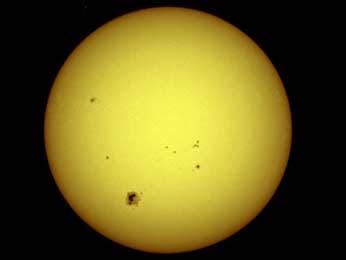HF Radio Propagation and Sunspots
- an overview of the basics of the effects that sunspots have on HF radio propagation and radio communications in general including two way radio communications, maritime mobile radio communications, mobile radio, radio broadcasting and amateur radio communications.
Solar effects on propagation includes:
Solar effects on radio propagation
Sunspots
Solar disturbances
SID sudden ionospheric disturbance
As electromagnetic waves, and in this case, radio signals travel, they interact with objects and the media in which they travel. As they do this the radio signals can be reflected, refracted or diffracted. These interactions cause the radio signals to change direction, and to reach areas which would not be possible if the radio signals travelled in a direct line.
HF radio communications of various forms including two way radio communications, maritime mobile radio communications, radio broadcasting, amateur radio communications, and in fact any form of radio communications that uses the HF bands and ionospheric radio propagation is very dependent upon the state of the ionosphere. The higher the levels of radiation received from the Sun, the greater the levels of ionisation in the ionosphere and in general this brings better propagation conditions for HF radio communications.
It is found that the number of sunspots on the Sun has a considerable effect on the levels of radiation emitted and hence impacting on the ionosphere. In turn this has a marked effect on radio communications of all forms. Sunspots are therefore of great interest to anyone involved in HF radio communications, as it affects the radio propagation conditions so significantly.

Image Coutesy NASA
What are sunspots?
If the sun is viewed by projecting its image onto a screen, dark areas can be seen from time to time. These can last anything from a few hours right up to several weeks. These spots are cool areas (relatively speaking) on the surface of the sun. The temperature is around only 3000°C against a sizzling 6000°C for the rest of the surface. It is much hotter under the surface reaching temperatures in excess of a million degrees Celsius.
A word of warning
Under no circumstances should the sun be viewed directly, even though dark glasses. In the past many people have had their sight damaged by doing this.
These sunspots are areas where there is intense magnetic activity. The fields in these areas are enormous and as a result the surface of the sun is disrupted. In these areas the surface cools dramatically causing a darker region to be perceived.
Around the sunspot there is an area called a plage. This is slightly brighter than the surrounding area and it is a large radiator of cosmic rays, ultra-violet light and X-rays. In fact it results in the overall level of radiation coming from the sun to increase. In turn this increased radiation level from around the sunspots causes the ionosphere to become ionised to a greater extent. This means that higher frequencies can be reflected from the ionosphere.
As sunspots appear in groups, especially the larger ones a sunspot number was devised. This is not the number of sunspots that are observed but a number indicating the level of sunspot activity. The number is very closely related to the actual amount radiation received from the Sun. In this way it is a good measure of solar activity. The daily readings are smoothed mathematically to take out the erratic variations to give the Smoothed Sunspot Number. Sometimes the abbreviation SSN is seen, and it is this smoothed sunspot number that it refers to.
Eleven year cycle
The number of sunspots on the surface of the sun varies with time. At times very few or even none may be visible, whereas at other times the number is very much greater. Although the number varies greatly over short periods of time as the sun rotates, careful analysis using the SSN reveals a longer term trend. It is found that over a period of approximately eleven years over which the sunspots vary. At the peak of this cycle conditions on the bands at the top of the short wave spectrum are very good. Low power stations can be heard over remarkably long distances. At the bottom of the cycle bands around 30 MHz will not usually support normal propagation via the ionosphere.
Sunspots have been observed by the Chinese since before the birth of Christ. However it was not until the mid-eighteenth century that astronomers started to keep records of sunspot numbers. By looking at these over the years it is possible to see the trend since then, and the cycles which have occurred since then. Cycle number 22 officially started in September 1986. It started with a sunspot number of 12 and rose rapidly over the following 33 months to reach a peak of 158. From its peak the sunspot number fell slightly and rose again to give a second, smaller peak before falling to bring the cycle to an end in 1996
Summary
The sunspot activity is of great importance to anyone involved in HF radio communications. Whether two way radio communications, maritime mobile communications, general mobile communications, point to point radio links, amateur radio communications, radio broadcasting or whatever form of radio communications. The level of sunspot activity has an enormous effect on the ionosphere and hence on HF radio propagation conditions. Accordingly even a superficial understanding is advantageous.
More Antenna & Propagation Topics:
EM waves
Radio propagation
Ionospheric propagation
Ground wave
Meteor scatter
Tropospheric propagation
Antenna basics
Cubical quad
Dipole
Discone
Ferrite rod
Log periodic antenna
Parabolic reflector antenna
Phased array antennas
Vertical antennas
Yagi
Antenna grounding
Installation guidelines
TV antennas
Coax cable
Waveguide
VSWR
Antenna baluns
MIMO
Return to Antennas & Propagation menu . . .



